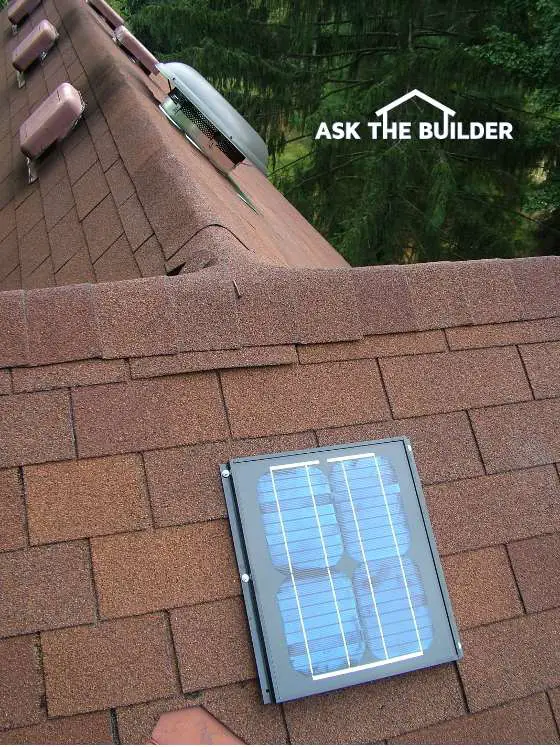Pedestal Bath Sinks and HOT Attic Myths

Pedestal Bath Sinks | These two pedestal sinks look great but might not be the most practical thing for a teenage girl. Narrow cabinets hide behind the mirrors, but no way will you or anyone be putting a hairdryer in one! Copyright 2020 Tim Carter
Pedestal Sinks
My childhood home had a pedestal sink. In the wall tile, there were two tiny alcoves, one for a drinking glass and the other for hand soap. There was also a wonderful ceramic toothbrush holder with four holes that protruded from the wall. I don’t recall electric hair dryers, curling irons, or any other modern appliance back then although a few people might have had them in the 1950s.
Above the sink was a traditional medicine cabinet with a mirrored door. The cabinet was about 3 inches deep which was plenty of space for medicine bottles, tweezers, shaving cream, razors, and other things you’d use to primp with as you got ready for the day or for bed. The back of the cabinet even had a slot where one could safely get rid of dull razor blades. Believe me, years later as a remodeler I carefully harvested hundreds of these in-wall cavities when tearing out walls!
Where Do You Put Things?
You may love the sleek look of a pedestal sink. I get that. But before you pull out your credit card to purchase one, think it through. Is there enough space on the pedestal sink to store all the things you need in your bathroom? Can the top surface of the pedestal even act as a work platform? It might be slanted and you can’t put anything safely on the narrow or tilted surface. Will an electric-powered thing fall into a sink full of water?
What about ten years from now? Do you have small kids that will use the sink? Is one or more a girl? When they approach teenage years and need all sorts of tools for their hair and face, where will these things rest and be stored? You can’t put them in a standard medicine cabinet, that’s for sure.
Vanity Tops Offer Storage Space
This is precisely why back in the 1960s, my mom and dad had our pedestal sink removed and installed as big a vanity cabinet with a flat top as could fit in the bathroom. Not only did the flat top allow more things to be stored next to the sink, but the spacious cabinet below also allowed for all sorts of things, including spare rolls of toilet paper, to be stored right there in the bathroom.
I’m not sure that it’s still taught in architecture school but there’s an axiom relating to function and form. It’s about the constant battle for something to look great but also be practical. All too often some people put the form first and function suffers. Pedestal sinks fit really well into this argument. What will win the battle as you plan your new bathroom for your existing home or your dream one?
Hot Attic Myths
I’m blessed to have written a free weekly newsletter for decades. You can subscribe to it on my AsktheBuilder.com website. Within hours of sending out each issue, subscribers respond with personal stories and things they want to add to an item I wrote about.
Solar Attic Fans are Useless
In my last issue, I published a reminder about how useless solar-powered attic fans are. I had installed several years ago and did an incense-smoke test to prove they move a tiny amount of air, most certainly not enough to cool down an attic where the temperature was 140 F or more.

This is a solar panel supplying free electricity to the attic fan under the silver dome on the rear roof. The fan blades spin, but they don't lower the attic temperature at all. Copyright 2018 Tim Carter
One of my wonderful subscribers got back saying that he listens to a radio show in a major Southwest city and the host is a remodeling contractor. The contractor warned that powered attic fans, especially those running on 120 volts, will always suck air-conditioned air from your home up into your attic.
This statement may be true if the house has no soffit or lower-roof ventilation, or if it does, it’s clogged. Powered attic fans that sit on a roof or in a gable vent will satisfy their appetite for air from the source of least resistance. You were supposed to learn this in your high school physics class. Great soffit vents provide this pathway instead of trying to suck air from inside the house through tiny holes or gaps in wall top plates.
Why Does an Attic Get Hot?
You need to understand that your roof structure, your attic floor, and the insulation in your attic is like a dying campfire in the evening. A campfire has glowing embers that continue to radiate heat for hours. It’s important to realize your roof can get as hot as 165 F, or higher, on a blazing hot summer day. The shingles heat up as does the roof lumber, sheathing, and everything in the attic. All of this material then tries to get rid of the heat through the night.
Does Insulation Get Hot?
Keep in mind that attic insulation gets hot. If you were to put a temperature probe into attic insulation you’d be stunned to discover the insulation itself can be well over 100 F on a summer night. Insulation is designed to slow the movement of heat. Heat is always trying to get to a colder state. This is a basic law of thermodynamics. This is why you must have amazing attic ventilation with as much air passing through the attic as possible.
How Can You Cool a Hot Attic?
You must try to get the entire roof, all the roof framing, etc. to the same temperature as the outdoor air as fast as possible. You can accelerate this process by bringing tens of thousands of cubic feet of outside air into your attic. A standard powered attic fan can move 96,000 cubic feet of air an hour through your attic sucking heat out of everything up in the attic. Be sure to always engage critical-thinking skills and common sense before you accept all you hear as gospel or fact.
Column 1364